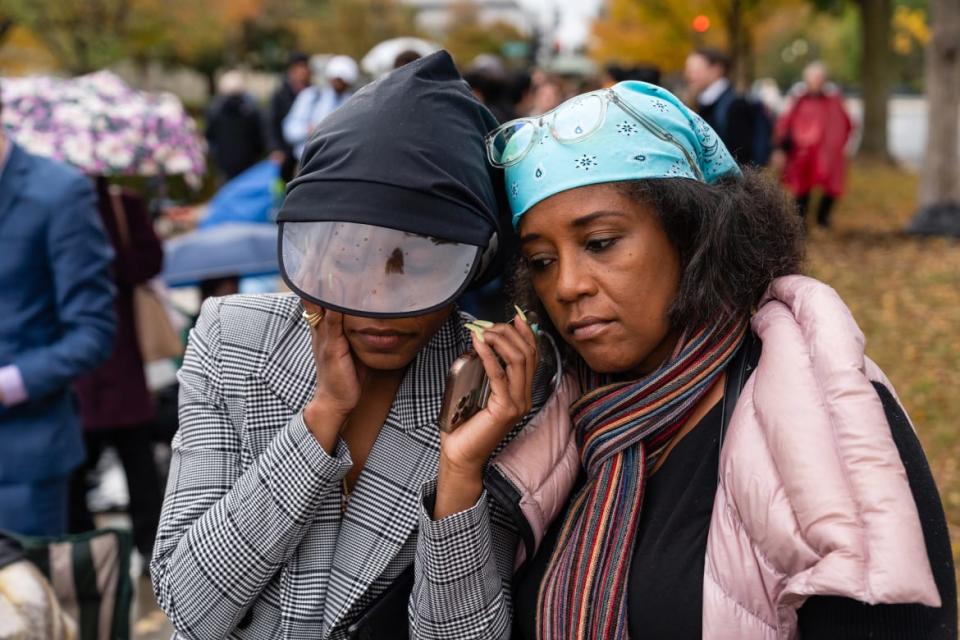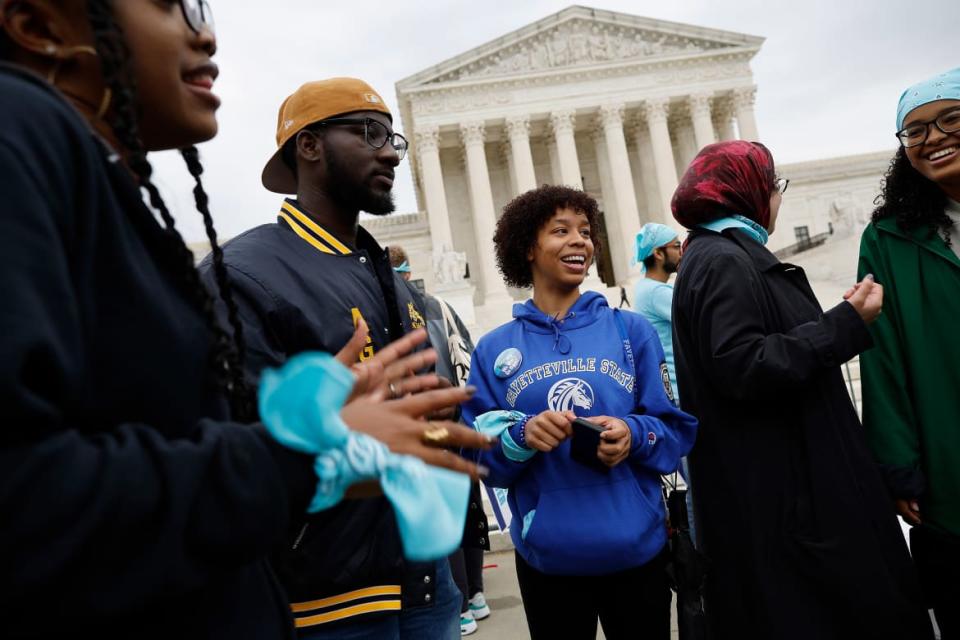Affirmative Action Is Gutted. Now’s the Time for Reparations

- Oops!Something went wrong.Please try again later.
Affirmative action was a promise to deliver economic justice to Black America that fell short. It was envisioned as an array of “helping hand” policies for the descendants of slaves designed by the authorities that had enslaved them. It offered a slow walk to restitution based on fair access to schools, loans, jobs, and housing.
The Supreme Court decision on college admissions upends the promise. By a vote of 6 to 3, the Court rejected the programs at Harvard University and the University of North Carolina as unlawful.
Supreme Court Deals Death Blow to College Affirmative Action
The decision involves the admissions processes at Harvard University and the University of North Carolina, the flagship institutions of private and public education. The cases share a common petitioner: Students for Fair Admissions (SFFA), a group whose members believe that the consideration of race in college admissions—even to correct historical wrongs of racism—is unconstitutional.
Chief Justice John Roberts, writing for the majority, agreed that the “admissions programs lack sufficiently focused and measurable objectives warranting the use of race, unavoidably employ race in a negative manner, involve racial stereotyping, and lack meaningful end points.”
The court decision puts a roadblock at the start of the journey to economic restitution, with consequences that can extend from education to employment and contracting.
The decision returns Black America to a crossroads of restitution for the wrongs of slavery and Jim Crow. Since the decades after the Civil War, the challenge has been to find pathways to economic justice. One strategy has looked to individual and class-action claims for reparations, another to the promise of affirmative action and inclusion.

Taylor Dumpson, 26, left, and her mother, Kimberly Dumpson, 53, right, listen to oral arguments for Students for Fair Admissions, Inc. v. University of North Carolina outside the Supreme Court last year.
The Shrinking of Affirmative Action
Since the 1930s, Black leadership has embraced government and company employment tools to break down historic barriers of race. Such policies worked to open doors in government offices, defense factories, and the armed services during World War II and afterward. By the 1960s, civil rights leaders expressed confidence that “affirmative action” policies could deliver a measure of economic justice.
The leaders promoted the policies with confidence in the support of two presidential administrations: On March 6, 1961, President John F. Kennedy issued Executive Order 10925, which called on government contractors to “take affirmative action” to hire inclusively. The commitment was deepened in 1965 when President Lyndon Johnson issued Executive Order 11246 to require fair employment practices by contractors.
From the start, however, the reliance on administrative tools as a primary means of restitution was stifled by persistent legal challenges, political opposition, and negative court decisions. Critics have promoted the alternative policy of a “colorblind” approach—though it has failed to address the historic and systemic inequities.
By 1996, California voters amended the state constitution to curtail affirmative action. When the University of California adopted the mandate in its admission policies, the result was a drop in Black American student enrollment at the upper-tier campuses.
The Supreme Court decision on the Harvard and UNC admissions programs will affect the way students apply to colleges and universities, and ultimately to the number of Black students enrolled in the schools with the most resources.
The Court decision noted that “nothing prohibits universities from considering an applicant’s discussion of how race affected the applicant’s life, so long as that discussion is concretely tied to a quality of character or unique ability that the particular applicant can contribute to the university.”
The Quest for Reparations
Since the Civil War, Black Americans have initiated claims for restitution for the unjust enrichment from slavery. Understand that more than 90 percent of Black Americans are related to the original 400,000 Africans brought to America as commodities of labor. The pool grew to more than 4 million by the Civil War and their bodies made America great.
America became an economic powerhouse from the institution of slavery, according to authors Sven Beckert and Seth Rockman in Slavery’s Capitalism: A New History of American Economic Development. Africans were the primary assets of national wealth as commodities for work, sale, rent, and childbirth. They helped to build the industries of agriculture, shipping, manufacturing, railroads, publishing, finance, and insurance.
Among the early claims for restitution was for 400,000 acres of coastal land between South Carolina, Georgia, and Florida. The region was awarded in reparation to emancipated Blacks in January 1865, under Special Field Order No. 15 by the Union Army Gen. William Tecumseh Sherman.
The order specified that “The islands from Charleston, south, the abandoned rice fields along the rivers for thirty miles back from the sea, and the country bordering the St. John’s River, Florida, are reserved and set apart for the settlement of the negroes now made free by the acts of war and the proclamation of the President of the United States.”
The reparations were reversed with the assassination of President Lincoln in April 1865, and Black settlers were either evicted or reduced to peonage with the return of white supremacy governments.
Another early claim was for state and federal pensions on behalf of the freedmen. In 1899, for example, The National Ex-Slave Mutual Relief, Bounty and Pension Association called on Congress to allocate pensions to the aged class. The appeal was ignored.
In addition to slavery, people have initiated claims for restitution for the unjust enrichment from Jim Crow, the laws and practices of racial subjugation. The loss of wages, farmland, family wealth, and markets for business stretched nearly a century from the close of the Civil War to the 1960s. Under Jim Crow, Black Americans were excluded from the transformational government programs of the 20th century, such as Social Security.
Among the notable claims for restitution in recent years was the 2002 lawsuit by attorney Deadria Farmer-Paellman. She filed a class action in federal court against financial institutions with ties to slavery. The claim received a degree of validation in the proceedings.
Attorney Patricia Muhammad explored appeals to the International Criminal Court in the book, The Trans-Atlantic Slave Trade: A Forgotten Crime against Humanity as Defined by International Law. In 2019, the United Nations High Commissioner on Human Rights concluded that the U.S. was among the states that owe reparations to the descendants of slaves.
In recent years, private actors have tried to find ways to wrest back stolen wealth, as documented by Ta-Nehisi Coates in his famous Atlantic essay, “The Case for Reparations.” Family claims have been made to recover the value of lost farmland, business, and homes through the instruments of deceit and violence, and the takings by eminent domain.
State and local institutions have also explored pathways to restitution, such as a California task force on reparations.

Students from Harvard College, North Carolina Agricultural and Technical State University and other HBCUs joined fellow proponents of affirmative action in higher education in front of the U.S. Supreme Court last year.
The Days Ahead
As the dust from the Supreme Court decision settles, Black political leaders would be prudent to explore a new agenda of restitution for the unjust enrichment from slavery and Jim Crow.
Any agenda should encourage reliable structures for filing claims. And it should prioritize the distribution of awards in the areas of pensions, workforce development, affordable housing, debt relief, health insurance, and youth recovery.
In 1972, Yale Law Professor Boris Bittker estimated the cost of reparations for slavery at about $1 trillion in the book, The Case for Black Reparations. Certainly, the debt has grown since then?
The agenda should also seek new ways to gain access to the resources—educational, employment, and contracting—of the upper-tier schools, most of which were enriched under slavery and Jim Crow. One approach is the reparation initiative by students at Georgetown University.
To be clear, the number of Black American students admitted to elite schools was modest even with affirmative action, but valuable to the formation of a middle class. The community probably will gain more from an agenda that directs investments to HBCUs and programs at community colleges and urban public colleges that serve large numbers of Black students.
Beyond the question of financial wholeness, the demand for reparations for slavery and Jim Crow has cultural merit as well. Randall Robinson, in “The Debt: What America Owes to Blacks,” argued that the debate helps America better understand the divergent pathways of race in the country’s history. The legacy of demands for reparations, the late Pan-African activist concluded, has roots in the dignity of Black America.
Get the Daily Beast's biggest scoops and scandals delivered right to your inbox. Sign up now.
Stay informed and gain unlimited access to the Daily Beast's unmatched reporting. Subscribe now.

